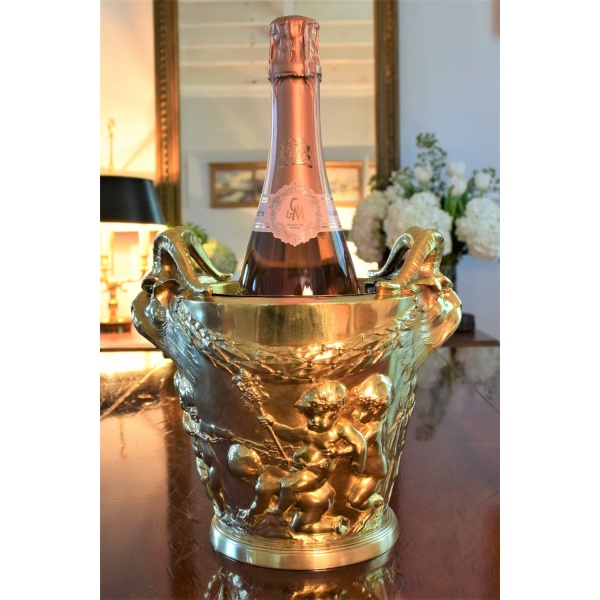Gorgeous 19th Century Ormolu Champagne Bucket~Sold~

Gorgeous French Ormolu Champagne Bucket With Chimera Ram Heads.
This beautiful Champagne bucket is constructed in ormolu of exceptional color and casting.
The Chimera or Mythical and Imaginary beasts, with Ram horns double as handles and show beautiful details.
The Main body of the bucket is decorated with an Allegory of a Bacchanalia with a Young Bacchus and his followers
In it we see Bacchus as a putto carrying his staff decorated with grapes and ribbons being paraded by putti and fauns while other putti are in the process of collecting grapes.
Baby Bacchus and another putto are carved in partial ronde-bosse, which give a lovely depth to the décor.
The upper part of the bucket is decorated with a lovely laurel wreath.
This piece was originally attributed to Clodion, but it is not signed, yet the beauty of the carving explains the attribution.
Claude Michel or Clodion, deserves a little more background.
He was born in Nancy on Dec. 20, 1738, into a family of sculptors. He studied with his uncle, Lambert Sigisbert Adam, a prominent sculptor whose work was significant in transforming the vigorous and dynamic baroque style into the more delicate rococo. Clodion also worked with the famous rococo sculptor Jean Baptiste Pigalle. In 1759 the Royal Academy awarded Clodion the Grand Prize for Sculpture, and he was in Rome between 1762 and 1771. During the 1770s he completed two important commissions for the Cathedral of Rouen: the marble St. Cecilia and the bronze Crucified Christ.
In 1773 he became a member of the academy. He created his most important works during the 1770s and 1780s.
Clodion, whose career spanned the last decades of the Ancien Régime through the French Revolution and Napoleon’s reign, embraced his era’s taste for antiquity.
He possessed great technical virtuosity and executed many types of sculpture in a variety of media.
Clodion is most noted for small, intimate terra-cotta sculptures or statuettes of nymphs, fauns, satyrs, and bacchantes, mythological creatures symbolic of erotic pleasure.
Such works as the Intoxication of Wine (Nymph and Satyr) and Seated Bacchante Playing with a Child are typical examples and are wholly within the decorative rococo traditions of 18th-century art. These graceful productions convey a mood of exuberant gaiety and depend for their effect upon a delicate play of highly refined textures; the soft medium of terra-cotta allowed Clodion to exploit fully and sensually the contrasting textural values of flesh, hair, fabric, fur, and foliage.
As early as the 1760s, the rococo style was under attack as frivolous and trivial, and during the last half of the century it was gradually replaced by a return to the relative severity of the art of antiquity. Clodion, however, was unaffected by the encroaching neoclassicism, and his statuettes remained popular until the French Revolution. During the Revolutionary and Napoleonic periods neoclassicism triumphed in the arts, and in his later works, such as the reliefs (1806) for the Arc du Carrousel in Paris, Clodion finally accepted the new style. He died in Paris on March 28, 1814.
The Champagne comes with its removable brass interior.
Paris, Circa 1870
H: 7.87"W: 6.49/L8.26"D: 6.1"Reference number: R-282
Click here to print.
go back
